From Participation to Involvement in Urban Open Space Management and Maintenance
Abstract
1. Introduction
2. Theoretical Framework
2.1. Management of Urban Open Spaces
2.2. Management Concepts
2.3. From Participation to Involvement
2.4. Management of Urban Biodiversity
3. Materials and Methods
3.1. Data Collection
3.2. Data Analysis
4. Results
4.1. Participation and Involvement
4.2. Participation and Continual Change in Biodiversity-Friendly Management
5. Discussion
5.1. Adaptive Management of Maintenance for Strong Involvement
5.2. Involvement as a Vehicle for Sustainability in a Changing Environment
5.3. Reliability of the Findings
6. Conclusions
Author Contributions
Funding
Institutional Review Board Statement
Informed Consent Statement
Data Availability Statement
Conflicts of Interest
References
- Baynes, T.M.; Wiedmann, T. General approaches for assessing urban environmental sustainability. Curr. Opin. Environ. Sustain. 2012, 4, 458–464. [Google Scholar] [CrossRef]
- Mumm, O.; Zeringue, R.; Dong, N.; Carlow, V.M. Green Densities: Accessible Green Spaces in Highly Dense Urban Regions—A Comparison of Berlin and Qingdao. Sustainability 2022, 14, 1690. [Google Scholar] [CrossRef]
- Wolfram, M. Cities shaping grassroots niches for sustainability transitions: Conceptual reflections and an exploratory case study. J. Clean. Prod. 2018, 173, 11–23. [Google Scholar] [CrossRef]
- Pantaloni, M.; Marinelli, G.; Santilocchi, R.; Minelli, A.; Neri, D. Sustainable Management Practices for Urban Green Spaces to Support Green Infrastructure: An Italian Case Study. Sustainability 2022, 14, 4243. [Google Scholar] [CrossRef]
- Wolfram, M. Conceptualizing urban transformative capacity: A framework for research and policy. Cities 2016, 51, 121–130. [Google Scholar] [CrossRef]
- Elmqvist, T.; Setälä, H.; Handel, S.; van der Ploeg, S.; Aronson, J.; Blignaut, J.; Gómez-Baggethun, E.; Nowak, D.; Kronenberg, J.; de Groot, R. Benefits of restoring ecosystem services in urban areas. Curr. Opin. Environ. Sustain. 2015, 14, 101–108. [Google Scholar] [CrossRef]
- Aronson, M.F.; Lepczyk, C.A.; Evans, K.L.; Goddard, M.A.; Lerman, S.B.; MacIvor, J.S.; Nilon, C.H.; Vargo, T. Biodiversity in the city: Key challenges for urban green space management. Front. Ecol. Environ. 2017, 15, 189–196. [Google Scholar] [CrossRef]
- Jansson, M.; Vogel, N.; Fors, H.; Dempsey, N.; Buijs; Randrup, T.B. Urban Open Space Governance and Management; Jansson, M., Randrup, T.B., Eds.; Routledge: New York, NY, USA, 2020; p. 12. [Google Scholar]
- Korpela, K.M.; Ylén, M. Perceived health is associated with visiting natural favourite places in the vicinity. Health Place 2007, 13, 138–151. [Google Scholar] [CrossRef] [PubMed]
- Wolch, J.R.; Byrne, J.; Newell, J.P. Urban green space, public health, and environmental justice: The challenge of making cities ‘just green enough’. Landsc. Urban Plan. 2014, 125, 234–244. [Google Scholar] [CrossRef]
- Rigolon, A.; Browning, M.H.E.M.; McAnirlin, O.; Yoon, H. Green Space and Health Equity: A Systematic Review on the Potential of Green Space to Reduce Health Disparities. Int. J. Environ. Res. Public Health 2021, 18, 2563. [Google Scholar] [CrossRef]
- Matos, P.; Vieira, J.; Rocha, B.; Branquinho, C.; Pinho, P. Modeling the provision of air-quality regulation ecosystem service provided by urban green spaces using lichens as ecological indicators. Sci. Total Environ. 2019, 665, 521–530. [Google Scholar] [CrossRef] [PubMed]
- Tahvonen, O. Scalable Green Infrastructure and the Water, Vegetation, and Soil System—Scaling-up from Finnish Domestic Gardens. Ph.D. Thesis, Aalto University, Espoo, Finland, 2019. [Google Scholar]
- Engle, N.L. Adaptive capacity and its assessment. Glob. Environ. Change 2011, 21, 647–656. [Google Scholar] [CrossRef]
- Lockwood, M.; Davidson, J.; Curtis, A.; Stratford, E.; Griffith, R. Governance Principles for Natural Resource Management. Soc. Nat. Resour. 2010, 23, 986–1001. [Google Scholar] [CrossRef]
- Molin, J.F.; Fors, H.; Faehnle, M. Citizen Participation for Better Urban Green Spaces. 2016. Available online: http://nordicforestresearch.org/wp-content/uploads/2017/07/Citizen-participation-PB-final.pdf (accessed on 19 June 2022).
- Kothencz, G.; Kolcsár, R.; Cabrera-Barona, P.; Szilassi, P. Urban Green Space Perception and Its Contribution to Well-Being. Int. J. Environ. Res. Public Health 2017, 14, 766. [Google Scholar] [CrossRef] [PubMed]
- Grahn, P.; Stigsdotter, U.K. The relation between perceived sensory dimensions of urban green space and stress restoration. Landsc. Urban Plan. 2010, 94, 264–275. [Google Scholar] [CrossRef]
- Smaniotto Costa, C.; Mathey, J.; Šuklje Erjavec, I. Green spaces—A key resources for urban sustainability. The GreenKeys approach for developing green spaces. Urbani Izziv. 2008, 19, 199–211. [Google Scholar] [CrossRef]
- Naumann, S.; McKenna, D.; Kaphengst, T.; Pieterse, M.; Rayment, M. Design, Implementation and Cost Elements of Green Infrastructure Projects; DG Environment, Ecologic Institute and GHK Consultingilon: Luxembourg, 2011. [Google Scholar]
- Nankervis, A.R.; Compton, R.L. Performance management: Theory in practice? Asia Pac. J. Hum. Resour. 2006, 44, 83–101. [Google Scholar] [CrossRef]
- Nartisa, I.; Putans, R.; Muravska, T. Strategic planning and management in public and private sector organizations in Europe: Copmaparative analysis and opportunities for improvement. Eur. Integr. Stud. 2012, 6. [Google Scholar] [CrossRef]
- Koontz, H. The management Theory Jungle. J. Acad. Manag. 1961, 4, 174–188. Available online: http://www.jstor.org/stable/254541 (accessed on 8 August 2022).
- Cole, G.A.; Kelly, P.P. Management Theory and Practice, 8th ed.; Cengage Learning: Boston, MA, USA, 2015; p. 624. [Google Scholar]
- Jansson, M.; Lindgren, T. A review of the concept ‘management’ in relation to urban landscapes and green spaces: Toward a holistic understanding. Urban For. Urban Green. 2012, 11, 139–145. [Google Scholar] [CrossRef]
- Eliassen, K.A.; Sitter, N. Understanding Public Management; SAGE Publications: London, UK, 2008; pp. 86–121. [Google Scholar]
- Hood, C. The New Public Management in the 1980s: Variation on a theme. Accounting. Oganisations Soc. 1995, 20, 93–109. [Google Scholar] [CrossRef]
- Barrie, C.; Swallow, P. Building Maintenance Management; John Wiley & Sons: Hoboken, NJ, USA, 2007. [Google Scholar]
- Dempsey, N.; Burton, M. Defining place-keeping: The long-term management of public spaces. Urban For. Urban Green. 2012, 11, 11–20. [Google Scholar] [CrossRef]
- Lee, K.N. Appraising adaptive management. Conserv. Ecol. 1999, 3, 3. Available online: http://www.consecol.org/vol3/iss2/art3/ua (accessed on 22 April 2022). [CrossRef]
- Nyberg, J.B. Statistics and the practice of adaptive management. In Statistical Methods for Adaptive Management Studies; Sit, V., Taylor, B., Eds.; Ministry of Forestry Government of British Columbia: Victoria, BC, Canada, 1998; pp. 1–5. [Google Scholar]
- Ambrose-Oji, B.; Tabbush, P.; Carter, C.; Frost, B.; Fielding, K.S. Public Engagement in Forestry: A Toolbox for Public Participation in Forest and Woodland Planning; Forestry Commission: Edinburgh, UK, 2011. Available online: http://www.forestry.gov.uk/forestry/infd-5xmf8l (accessed on 20 April 2022).
- Mäenpää, P.; Faehnle, M. 4.S: Kuinka Kaupunkiaktivismi Haastaa Hallinnon, Muuttaa Markkinat ja Laajentaa Demokratiaa; Vastapaino: Tampere, Finland, 2021. [Google Scholar]
- Land Use and Building Act. 6§. Finlex. Available online: https://www.finlex.fi/fi/laki/ajantasa/1999/19990132 (accessed on 4 May 2022). (In Finnish).
- Kopáček, M. Land-Use Planning and the Public: Is There an Optimal Degree of Civic Participation? Land 2021, 10, 90. [Google Scholar] [CrossRef]
- Randrup, T.B.; Persson, B. Public green spaces in the Nordic countries: Development of a new strategic management regime. Urban For. Urban Green. 2009, 8, 31–40. [Google Scholar] [CrossRef]
- Jansson, M.; Vogel, N.; Fors, H.; Randrup, T.B. The governance of landscape management: New approaches to urban open space development. Landsc. Res. 2019, 44, 952–965. [Google Scholar] [CrossRef]
- Jensen, M.B.; Persson, B.; Guldager, S.; Reeh, U.; Nilsson, K. Green structure and sustainability developing a tool for local planning. Landsc. Urban Plan. 2000, 17, 117–133. [Google Scholar] [CrossRef]
- Bennett, E.M.; Cramer, W.; Begossi, A.; Cundill, G.; Díaz, S.; Egoh, B.N.; Geijzendorffer, I.R.; Krug, C.B.; Lavorel, S.; Lazos, E.; et al. Linking biodiversity, ecosystem services, and human well-being: Three challenges for designing research for sustainability. Curr. Opin. Environ. Sustain. 2015, 14, 76–85. [Google Scholar] [CrossRef]
- Sites. The Sustainable Sites Initiative. 2016. Available online: https://www.usgbc.org/resources/sites-rating-system-and-scorecard (accessed on 12 July 2022).
- Randrup, T.; Östberg, J. Hållbar Grönyteskötsel. Alnarp. 2017. Available online: https://pub.epsilon.slu.se/14164/ (accessed on 3 May 2022).
- Viherympäristöliitto 2019. Sustainable Landscape Construction. 2019. Available online: https://www.vyl.fi/tietopankki/kesy/sustainable-landscape-construction/ (accessed on 6 May 2022).
- City of Berlin. 2016. Available online: https://www.berlin.de/sen/uvk/natur-und-gruen/stadtgruen/pflegen-und-unterhalten/handbuch-gute-pflege/ (accessed on 2 April 2022).
- Viherympäristöliitto 2020. RAMS Classification for Maintenance. 2020. Available online: https://www.vyl.fi/ohjeet/kunnossapitoluokitus/rams-materiaalit/ (accessed on 6 May 2022). (In Finnish).
- Cabe. A Guide to Producing Park and Green Space Management Plans. 2009. Available online: https://www.greenflagaward.org/media/1122/management_plan_guidance-15.pdf (accessed on 7 May 2022).
- Vardouli, T. Who Designs? In Empowering Users through Design; Bihanic, D., Ed.; Springer International Publishing: Cham, Switzerland, 2015; pp. 13–41. [Google Scholar] [CrossRef]
- IAP2. Advancing the Practice of Public Participation. International Association for Public Participation. 2016. Available online: https://www.iap2.org/mpage/Home (accessed on 7 May 2022).
- Bahnareanu, A. Public Leadership and Citizen Engagement. SSRN Electron. J. 2011. [Google Scholar] [CrossRef]
- Arnstein, S.R. A Ladder of Citizen Participation. J. Am. Inst. Plan. 1969, 35, 216–224. [Google Scholar] [CrossRef]
- Steen Møller, M.; Stahl Olafsson, A. The Use of E-Tools to Engage Citizens in Urban Green Infrastructure Governance: Where Do We Stand and Where Are We Going? Sustainability 2018, 10, 3513. [Google Scholar] [CrossRef]
- Bell, S. Landscape pattern, perception and visualisation in the visual management of forests. Landsc. Urban Plan. 2001, 54, 201–211. [Google Scholar] [CrossRef]
- De Haas, W.; Hassink, J.; Stuiver, M. The Role of Urban Green Space in Promoting Inclusion: Experiences from The Netherlands. Front. Environ. Sci. 2021, 9, 618198. [Google Scholar] [CrossRef]
- Texas A&M AgriLife Extension Service. Encouraging Citizen Input on Parks: Getting Out of the Boardroom. 2021. Available online: https://agrilifeextension.tamu.edu/library/community-development-parks-recreation-tourism/encouraging-citizen-input-on-parks-getting-out-of-the-boardroom/ (accessed on 1 June 2022).
- Fors, H.; Hagemann, F.A.; Sang, Å.O.; Randrup, T.B. Striving for Inclusion—A Systematic Review of Long-Term Participation in Strategic Management of Urban Green Spaces. Front. Sustain. Cities 2021, 3, 572423. [Google Scholar] [CrossRef]
- Rauws, W. Embracing Uncertainty Without Abandoning Planning: Exploring an Adaptive Planning Approach for Guiding Urban Transformations. DisP Plan. Rev. 2017, 53, 32–45. [Google Scholar] [CrossRef]
- Siebers, V.; Torfing, J. Co-Creation as a New Form of Citizens Engagement: Comparing Danish and Dutch Experiences at the Local Government Level. Int. Public Manag. Rev. 2018, 18, 187–208. Available online: https://forskning.ruc.dk/en/publications/co-creation-as-a-new-form-of-citizen-engagement-comparing-danish. (accessed on 12 May 2022).
- Ives, C.D.; Lentini, P.E.; Threlfall, C.G.; Ikin, K.; Shanahan, D.F.; Garrard, G.E.; Bekessy, S.A.; Fuller, R.A.; Mumaw, L.; Rayner, L.; et al. Cities are hotspots for threatened species: The importance of cities for threatened species. Glob. Ecol. Biogeogr. 2016, 25, 117–126. [Google Scholar] [CrossRef]
- Nilon, C.H. Urban biodiversity and the importance of management and conservation. Landsc. Ecol. Eng. 2011, 7, 45–52. [Google Scholar] [CrossRef]
- Werner, P.; Zahner, R. Biological Diversity and Cities: A Review and Bibliography; Bundesamt fur Naturschutz: Leipzig, Germany, 2009; BfN-Skripten 245. [Google Scholar]
- McIntyre, N.E. Ecology of Urban Arthropods: A Review and a Call to Action. Ann. Entomol. Soc. Am. 2000, 93, 825–835. [Google Scholar] [CrossRef]
- McIntyre, N.E.; Rango, J.; Fagan, W.F.; Faeth, S.H. Ground arthropod community structure in a heterogeneous urban environment. Landsc. Urban Plan. 2001, 52, 257–274. [Google Scholar] [CrossRef]
- Sandoval, L. Urban Habitat Management that Could Attract Species that Otherwise Avoid Cities. Blog Text in The Nature of Cities. 2018. Available online: https://www.thenatureofcities.com/page/44/?cat=trees (accessed on 10 August 2022).
- Harrison, C.; Davies, G. Conserving biodiversity that matters: Practitioners’ perspectives on brownfield development and urban nature conservation in London. J. Environ. Manag. 2002, 65, 95–108. [Google Scholar] [CrossRef] [PubMed]
- Cilliers, S. Urban Biodiversity and Design; Müller, M., Werner, P., Kelcey, J.G., Eds.; Blackwell Publishing Ltd.: Oxford, UK, 2010. [Google Scholar] [CrossRef]
- Loss, S.R.; Ruiz, M.O.; Brawn, J.D. Relationships between avian diversity, neighborhood age, income, and environmental characteristics of an urban landscape. Biol. Conserv. 2009, 142, 2578–2585. [Google Scholar] [CrossRef]
- Evans, G.W. The built environment and mental health. J. Urban Health 2003, 80, 536–555. [Google Scholar] [CrossRef] [PubMed]
- Brindley, P.; Jorgensen, A.; Maheswaran, R. Domestic gardens and self-reported health: A national population study. Int. J. Health Geogr. 2018, 17, 31. [Google Scholar] [CrossRef]
- Mills, J.G.; Brookes, J.D.; Gellie, N.J.C.; Liddicoat, C.; Lowe, A.J.; Sydnor, H.R.; Thomas, T.; Weinstein, P.; Weyrich, L.S.; Breed, M.F. Relating Urban Biodiversity to Human Health With the ‘Holobiont’ Concept. Front. Microbiol. 2019, 10, 550. [Google Scholar] [CrossRef]
- Brinsmead, T.; Hooker, C. Complex Systems Dynamics and Sustainability: Conseption, Method and Policy. In Philosophy of Complex Systems; Gabbay, M., Thagard, P., Woods, J., Hooker, C., Woods, J., Eds.; Elsevier Science & Technology: London, UK, 2011; pp. 809–840. [Google Scholar]
- Sardi, A.; Sorano, E. Dynamic Performance Management: An Approach for Managing the Common Goods. Sustainability 2019, 11, 6435. [Google Scholar] [CrossRef]
- Yin, R.K. Case Study Research: Design and Method; Sage: Thousand Oaks, CA, USA, 2003. [Google Scholar]
- Ørngreen, R.; Levinsen, K. Workshops as a Research Methodology. Electr. J. E-Learn. 2017, 15, 70–81. [Google Scholar]
- Thoring, K.; Mueller, R.M.; Badke-Schaub, P. Workshops as a Research Method: Guidelines for Designing and Evaluating Artifacts Through Workshops. Conference Proceedings. 2020. Available online: https://hdl.handle.net/10125/64362 (accessed on 7 August 2022).
- Smit, E.G.; Van Noort, G.; Voorveld, H.A.M. Understanding online behavioural advertising: User knowledge, privacy concerns and online coping behaviour in Europe. Comput. Hum. Behav. 2014, 32, 15–22. [Google Scholar] [CrossRef]
- Abrell, T.; Benker, A.; Pihlajamaa, M. User knowledge utilization in innovation of complex products and systems: An absorptive capacity perspective. Creat. Innov. Manag. 2018, 27, 169–182. [Google Scholar] [CrossRef]
- Joshi, A.; Kale, S.; Chandel, S.; Pal, D. Likert Scale: Explored and Explained. Br. J. Appl. Sci. Technol. 2015, 7, 396–403. [Google Scholar] [CrossRef]
- Harpe, S.E. How to analyze Likert and other rating scale data. Curr. Pharm. Teach. Learn. 2015, 7, 836–850. [Google Scholar] [CrossRef]
- Mayring, P. Qualitative Content Analysis. Forum Qual. Soc. Res. 2000, 1, 159–176. [Google Scholar] [CrossRef]
- Campbell, M.O. Adaptive Management of Green Spaces and Life Quality in Glasgow (Scotland) and Ottawa (Canada). In Multidimensional Approach to Quality of Life Issues; Sinha, B., Ed.; Springer: Singapore, 2019; pp. 309–324. [Google Scholar] [CrossRef]
- Schulz, K.; Mnisri, K. Pathways to Connect Creativity and Sustainable Development; Pun-editions Universitaires de Lorraine Artem Occ., ICN Business School Publication: Nancy, France, 2020. [Google Scholar]
- Zolkafli, A.; Brown, G.; Liu, Y. An Evaluation of the Capacity-building Effects of Participatory GIS (PGIS) for Public Participation in Land Use Planning. Plan. Pract. Res. 2017, 32, 385–401. [Google Scholar] [CrossRef]
- Randrup, T.B.; Buijs, A.; Konijnendijk, C.C.; Wild, T. Moving beyond the nature-based solutions discourse: Introducing nature-based thinking. Urban Ecosyst. 2020, 23, 919–926. [Google Scholar] [CrossRef]
- Puskás, N.; Abunnasr, Y.; Naalbandian, S. Assessing deeper levels of participation in nature-based solutions in urban landscapes—A literature review of real-world cases. Landsc. Urban Plan. 2021, 210, 104065. [Google Scholar] [CrossRef]
- Wolff, A.; Pässilä, A.; Knutas, A.; Vainio, T.; Lautala, J.; Kantola, L. The Importance of Creative Practices in Designing More-Than-Human Cities. In Handbook of Smart Cities; Augusto, J.C., Ed.; Springer Nature: Cham, Switzerland, 2021; pp. 2–20. [Google Scholar]
- Suomalainen, S.; Kahiluoto, H.; Pässilä, A.; Owens, A.; Holtham, C. Arts-Aided Recognition of Citizens´ Perceptions for Urban Open Space Management. Sustainability 2021, 14, 135. [Google Scholar] [CrossRef]
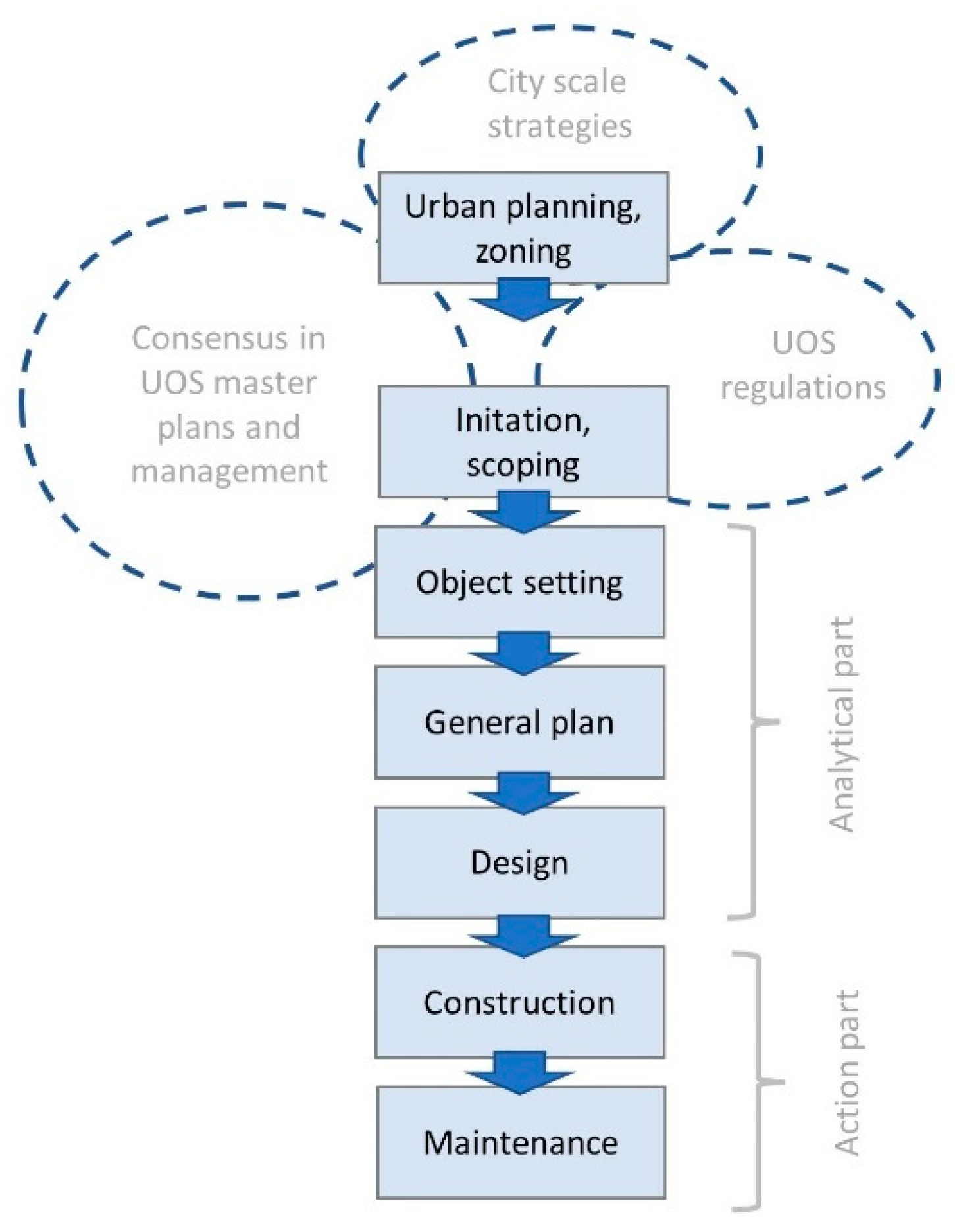
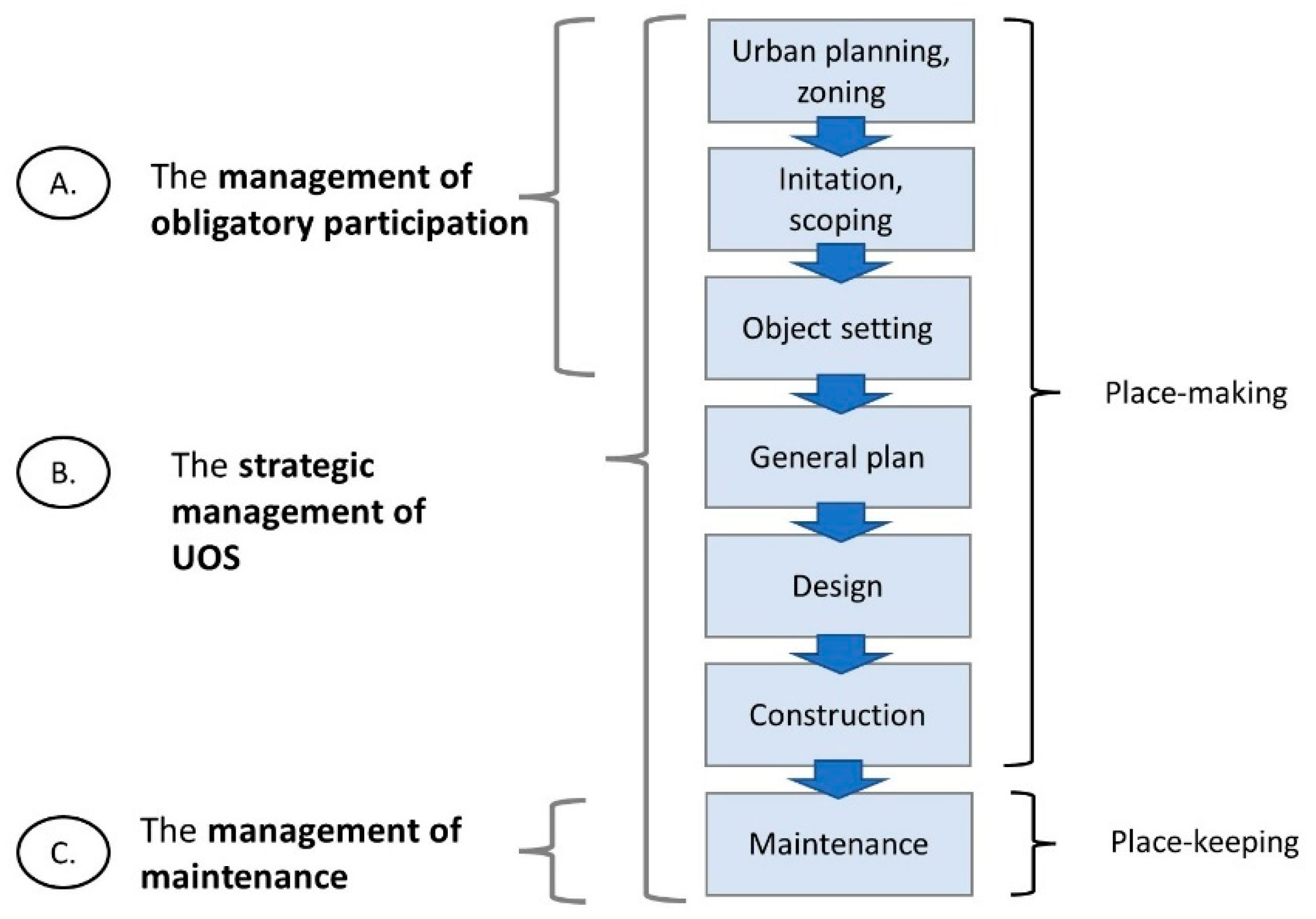

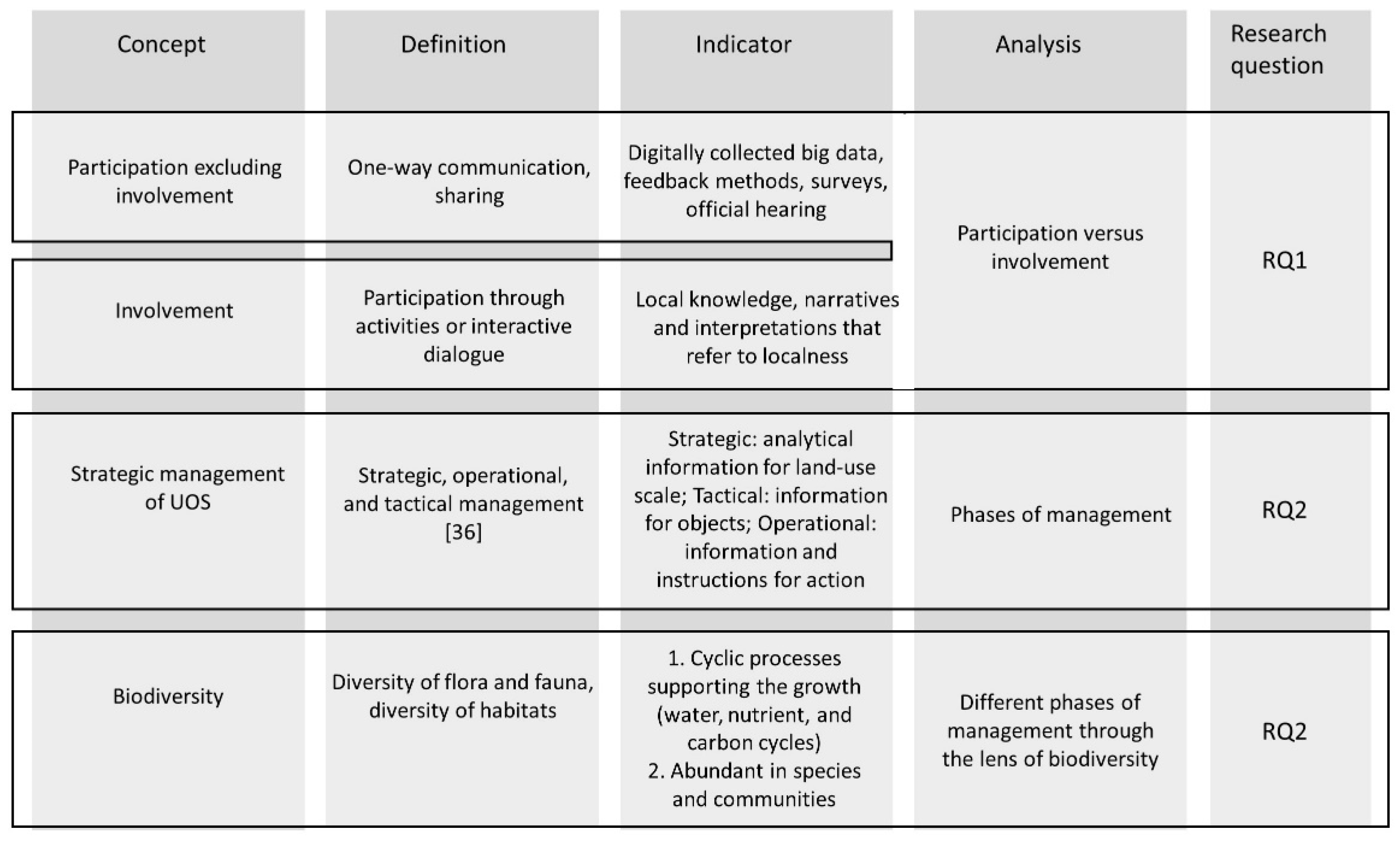
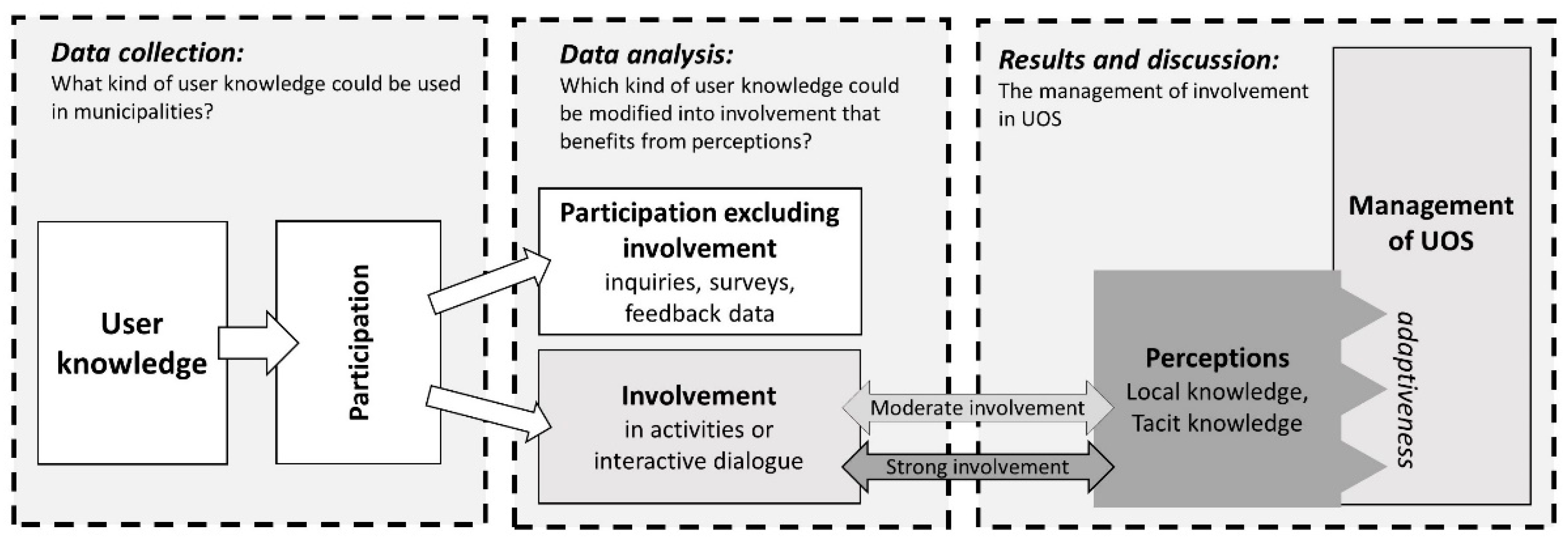
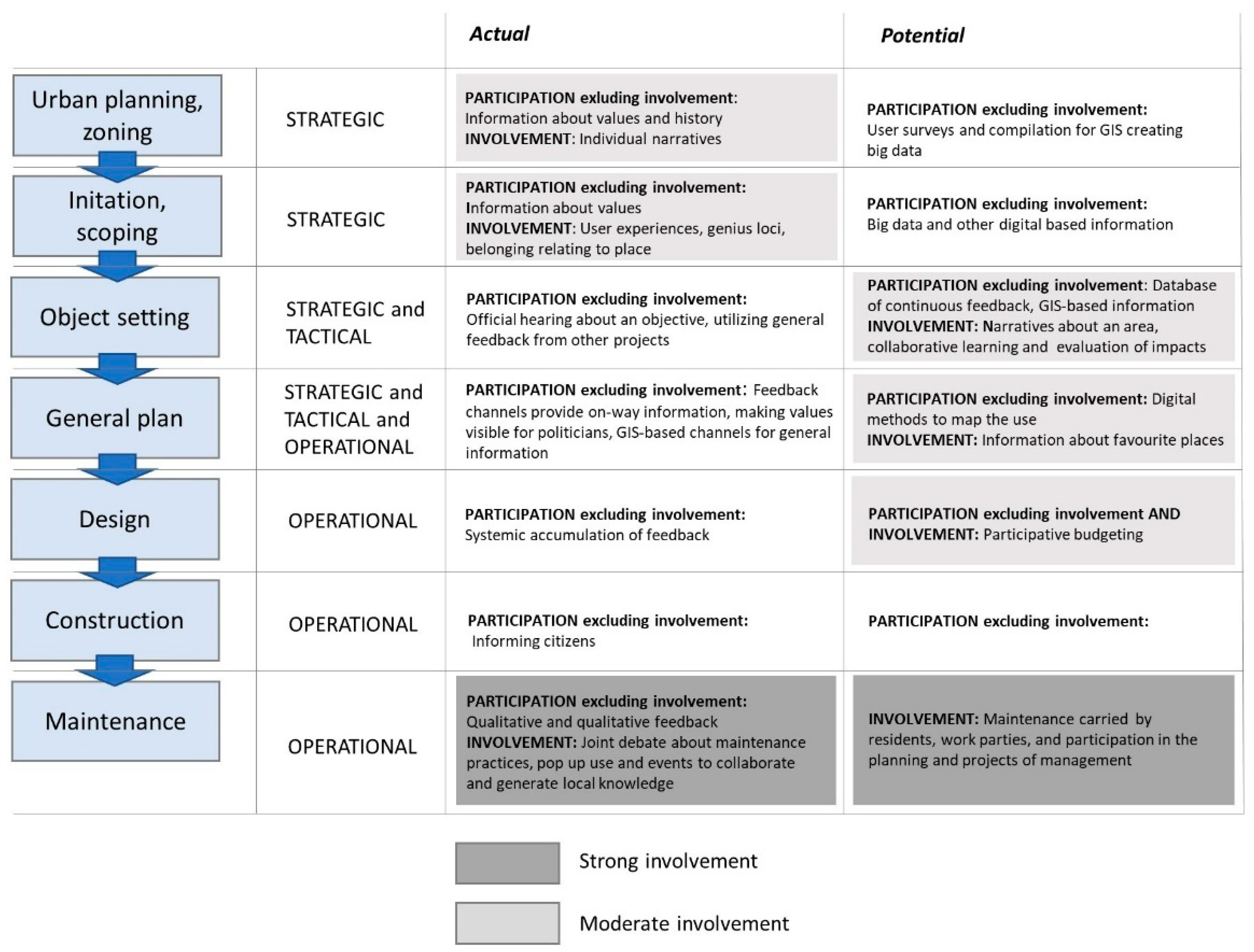
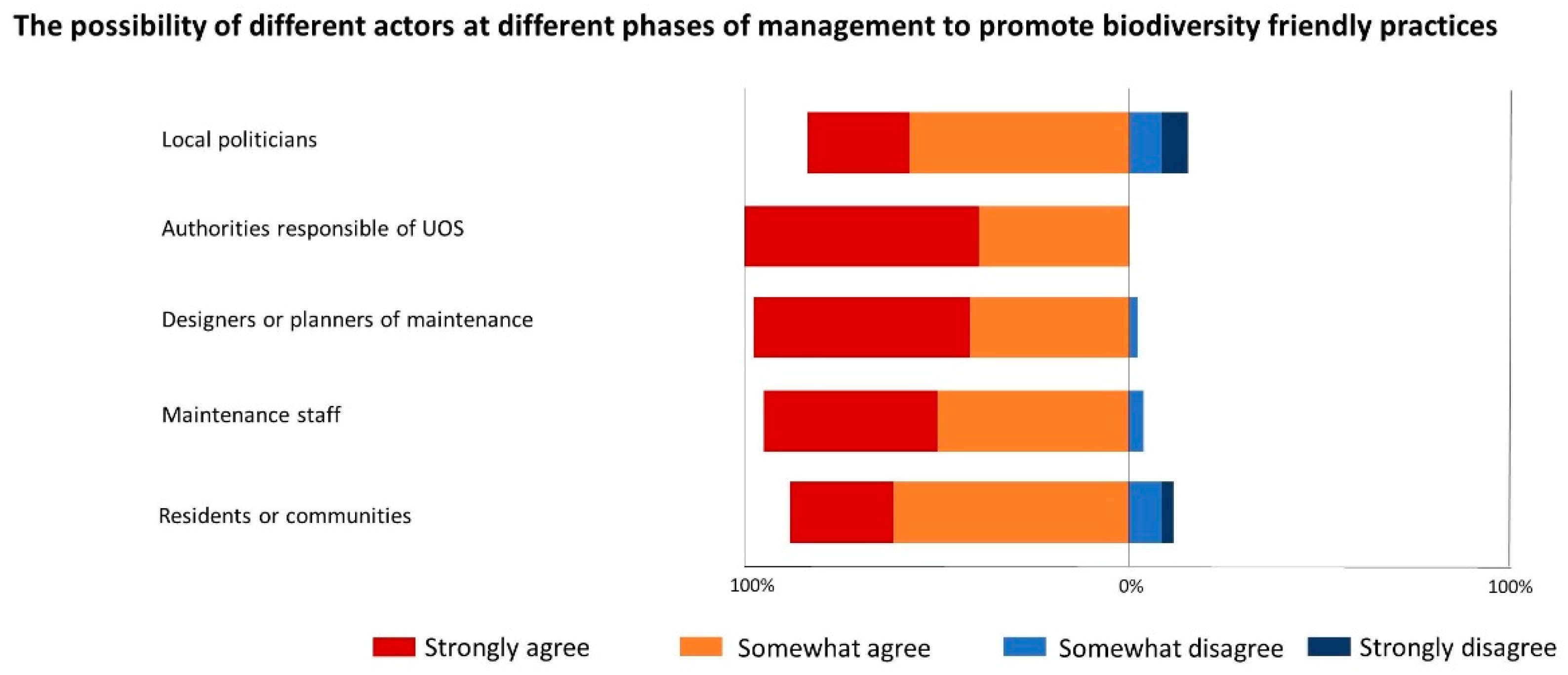
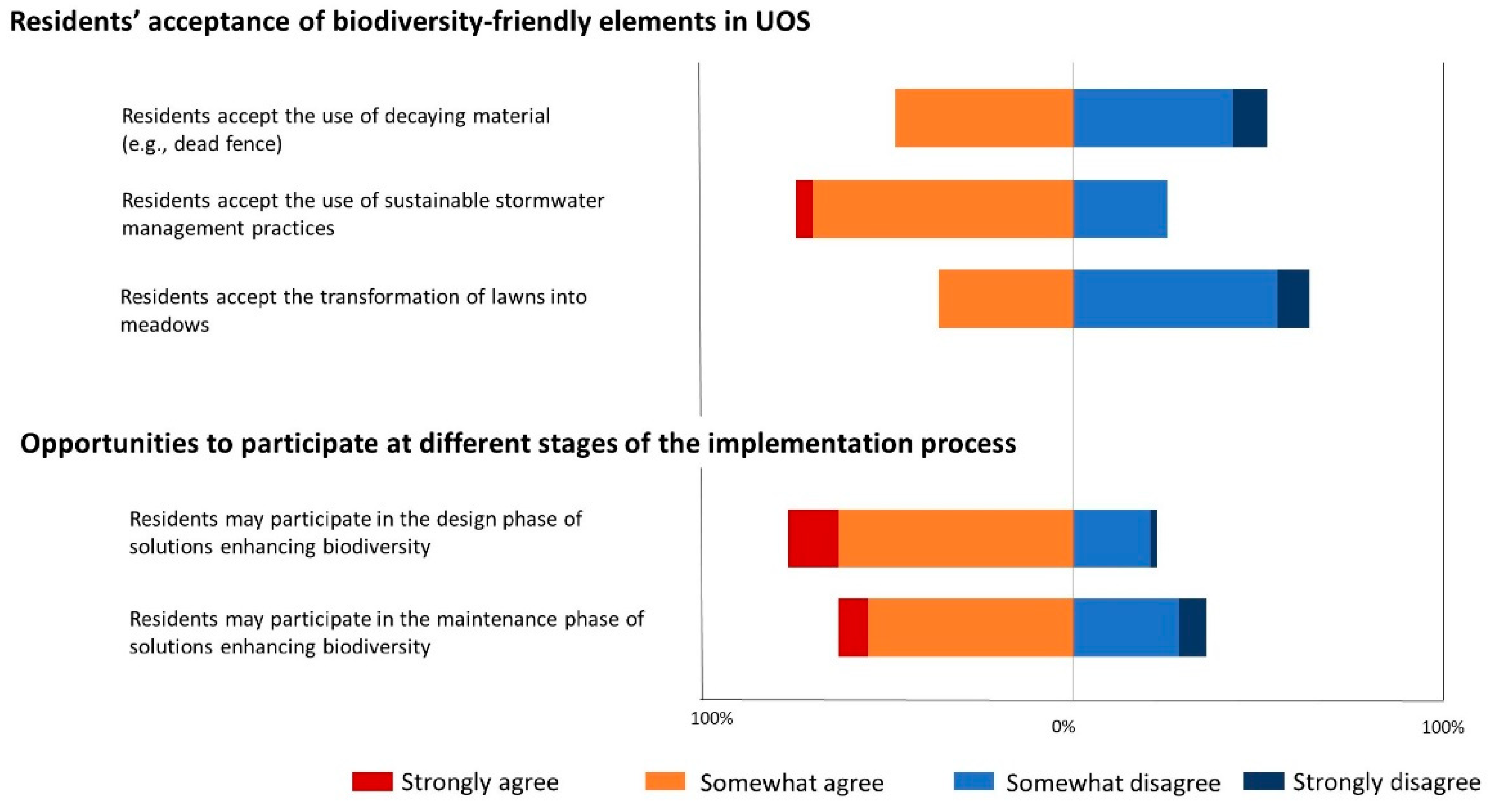
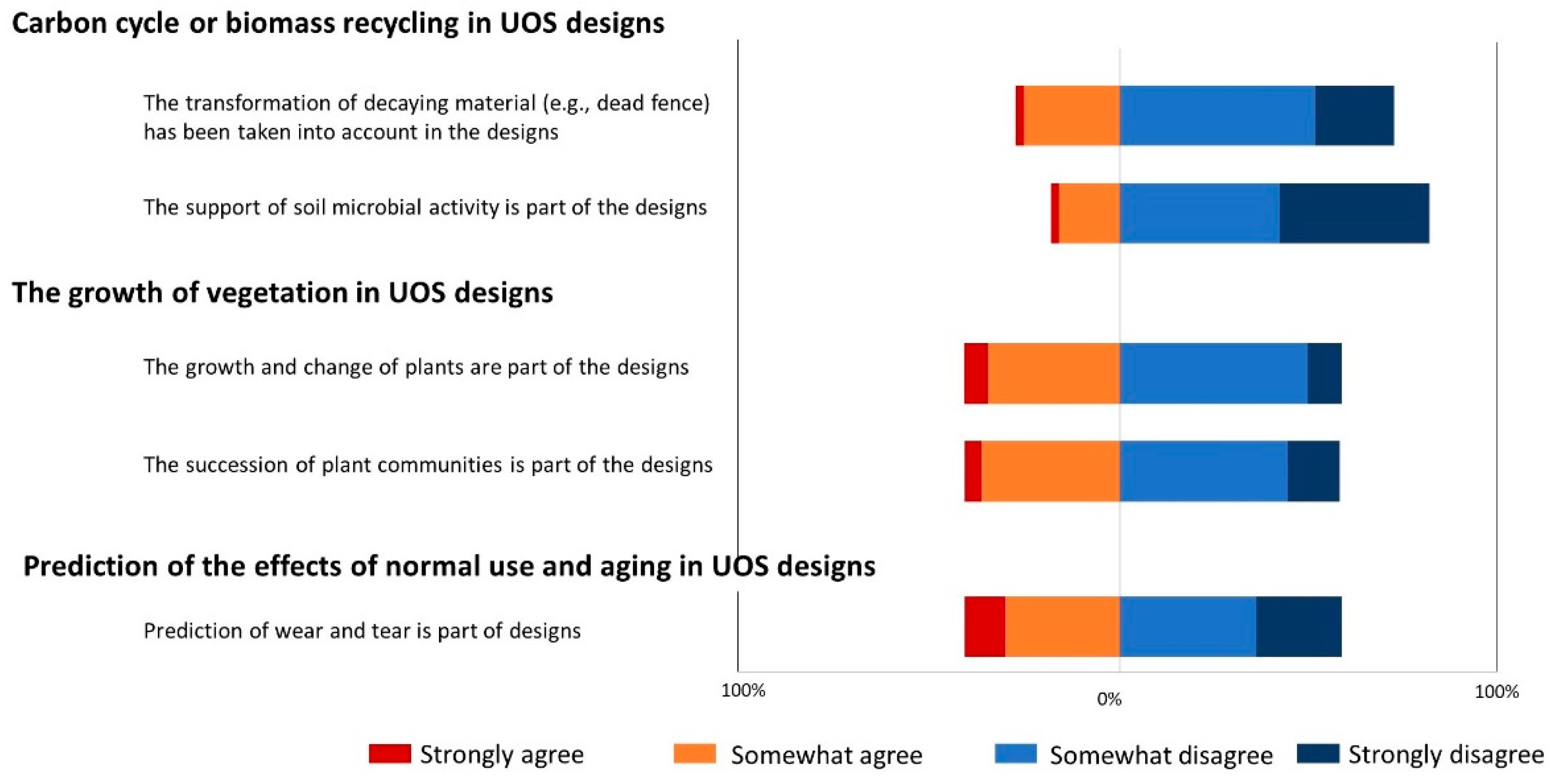
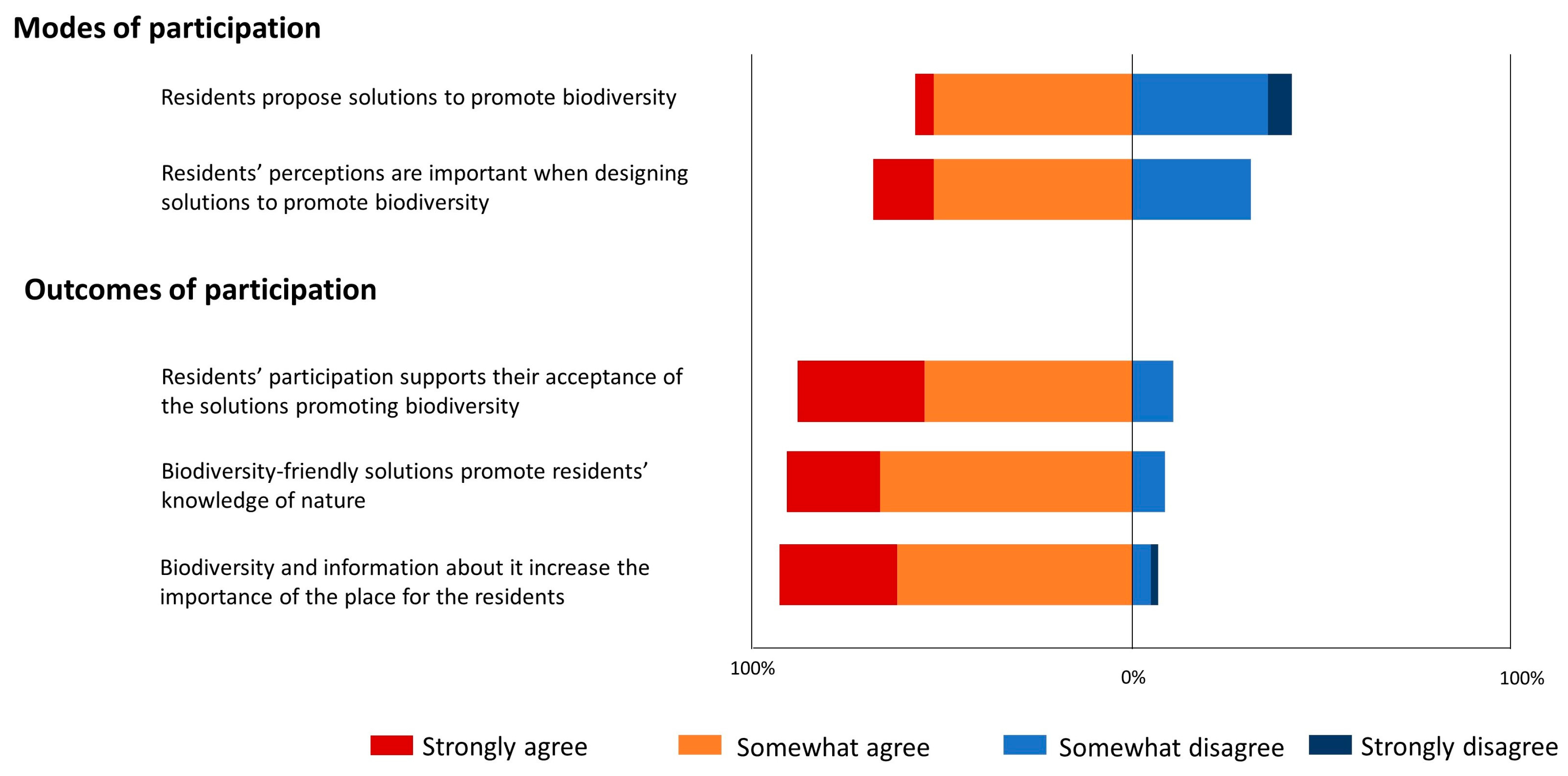
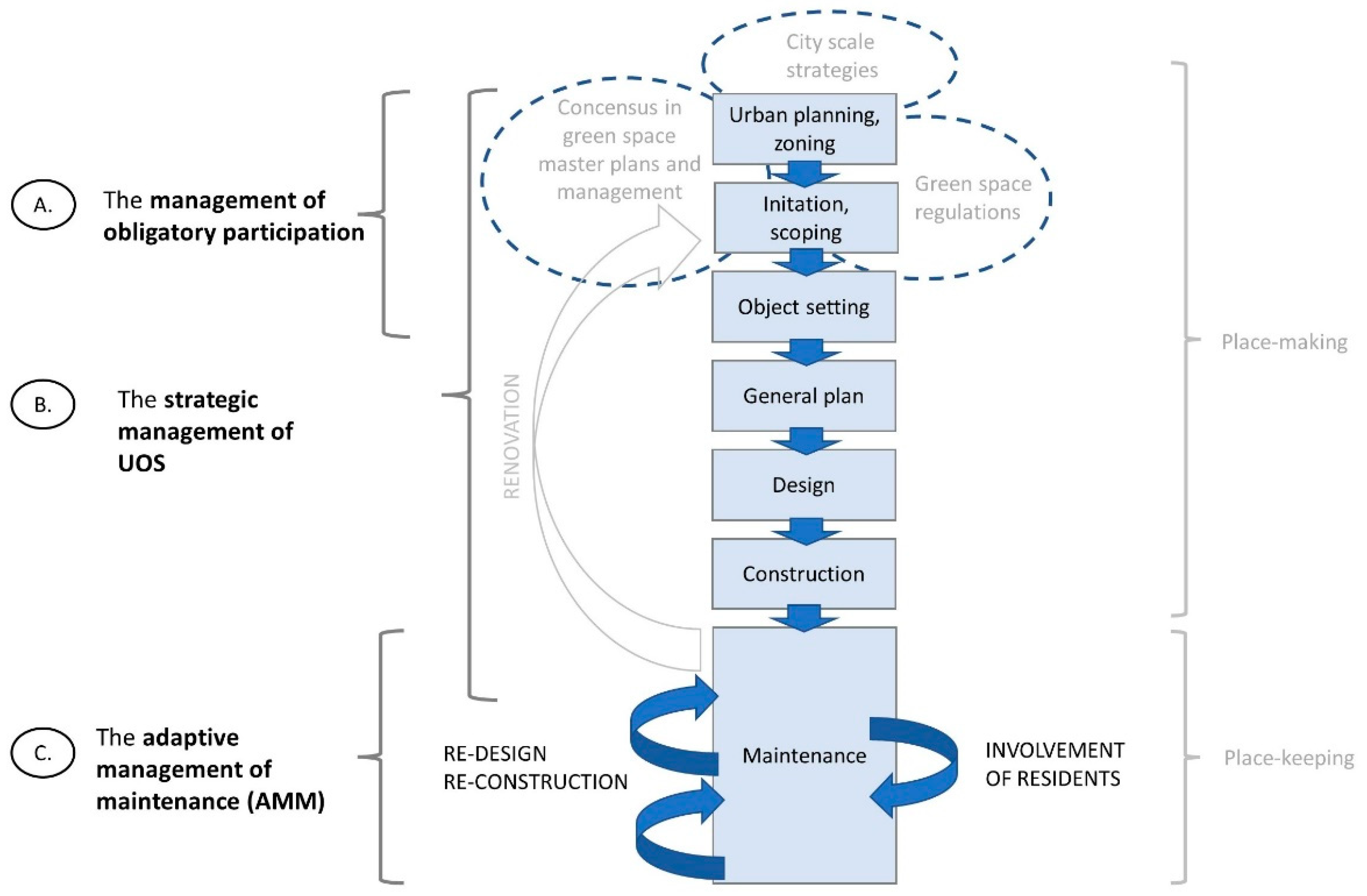
Publisher’s Note: MDPI stays neutral with regard to jurisdictional claims in published maps and institutional affiliations. |
© 2022 by the authors. Licensee MDPI, Basel, Switzerland. This article is an open access article distributed under the terms and conditions of the Creative Commons Attribution (CC BY) license (https://creativecommons.org/licenses/by/4.0/).
Share and Cite
Suomalainen, S.; Tahvonen, O.; Kahiluoto, H. From Participation to Involvement in Urban Open Space Management and Maintenance. Sustainability 2022, 14, 12697. https://doi.org/10.3390/su141912697
Suomalainen S, Tahvonen O, Kahiluoto H. From Participation to Involvement in Urban Open Space Management and Maintenance. Sustainability. 2022; 14(19):12697. https://doi.org/10.3390/su141912697
Chicago/Turabian StyleSuomalainen, Sari, Outi Tahvonen, and Helena Kahiluoto. 2022. "From Participation to Involvement in Urban Open Space Management and Maintenance" Sustainability 14, no. 19: 12697. https://doi.org/10.3390/su141912697
APA StyleSuomalainen, S., Tahvonen, O., & Kahiluoto, H. (2022). From Participation to Involvement in Urban Open Space Management and Maintenance. Sustainability, 14(19), 12697. https://doi.org/10.3390/su141912697







